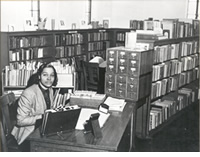Celebrate Robinson Library!
This week we have the opportunity to honor Robinson Library. While many people know of the local history of the Kate Waller Barrett Library, of the 1939 Library Sit-In, and of the creation of the Robinson Library as a “separate but equal” institution, many people do not know that there was a long history of advocacy for a library to serve the African American community. The Robinson Library was the culmination of advocacy dating back to 1875 when the Virginia Historical and Literary Society served as the first “colored” library. From 1888 to 1919, Magnus Robinson and his brother, Robert B. Robinson utilized various organizations to advocate for funding for a library for the African American community. Thus, when the library board responded to the Sit-In in the August 28th issue of the Alexandria Gazette with "it took 143 years for the white people to obtain the library the city now has. Our colored citizens have been seeking a similar privilege for only 2 years," they were ignoring a long history of activism.
Even though a “separate but equal” library was not the result Sit-In organizer and attorney Samuel W. Tucker had hoped for, Robinson Library was still a vital and desired resource for the African American community. Designed by Ward Brown of Alexandria, the building was completed for approximately $4,500 in comparison to the $15,000 price tag for Barrett Library. Once constructed, the Robinson Library was named for Robert H. Robinson. It was managed by Evelyn Roper Beam, a fully credentialed African American librarian. Beam was paid $720 per year compared with the $1,940 salary for Barrett’s assistant librarian. From Board records, it is apparent there was a quick succession of librarians for Robinson Library until 1944 when Sara Murphy Carr took over management of the library. Carr, just as her predecessors, was not allowed to address the Library Board directly. Instead, she had to submit written reports to Barrett's Librarian Katherine A. Scoggin. However, her fortitude kept her in the position and provided stability and a much beloved story hour for children. Upon her departure, the library was unable to secure another credentialed librarian, so Mrs. Gladys Davis, an Alexandria native, became the librarian. She worked for the Alexandria Library for more than 60 years.
Integration of the Robinson and Barrett Libraries
Integration in Alexandria Libraries began in February 1959, when African American high school students and adults could use Barrett Library. By 1960, Robinson Library was a children’s branch, but it closed on 1 July 1962 when children’s services moved to Barrett library. Eventually, the building became the Alexandria Black History Museum we know today as a testament to the resilience of Alexandria’s African American community.
As we celebrate National Library Week during this highly unusual year, think about the effort put forth by earlier generations to have equal access to library services. The public library - find your place at the library and the library at your place.
Last updated: April 22, 2020










